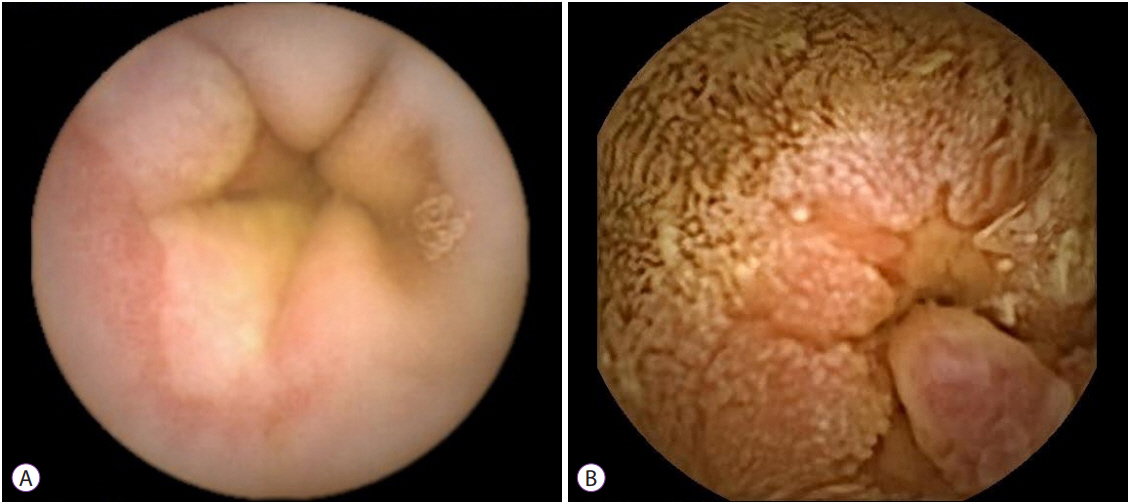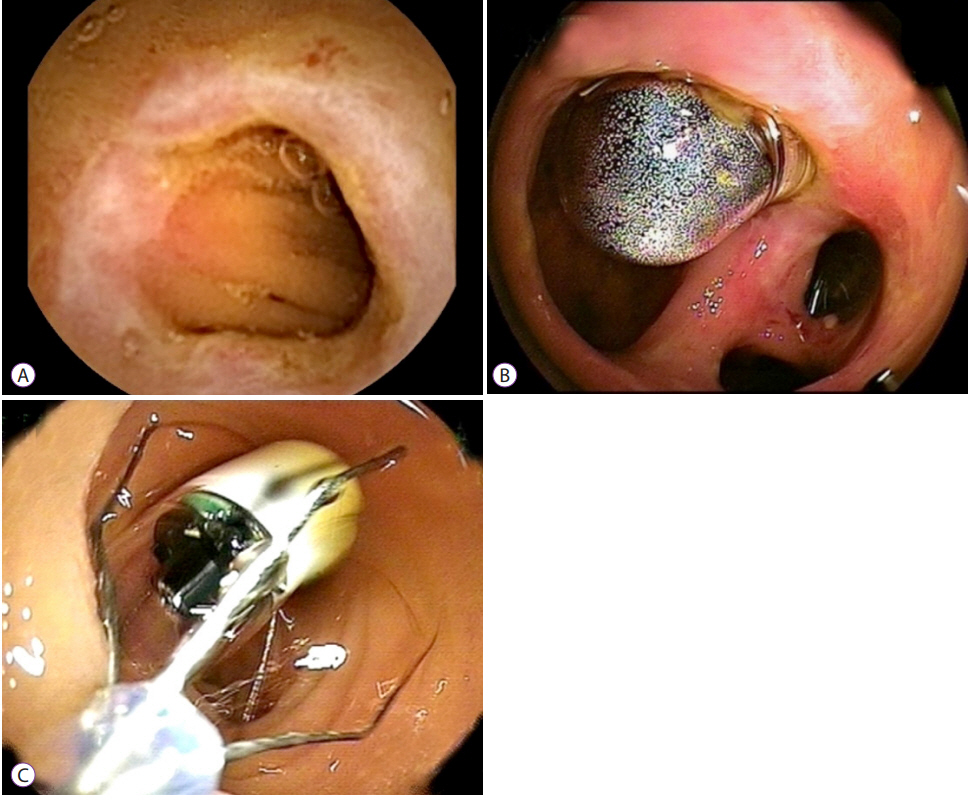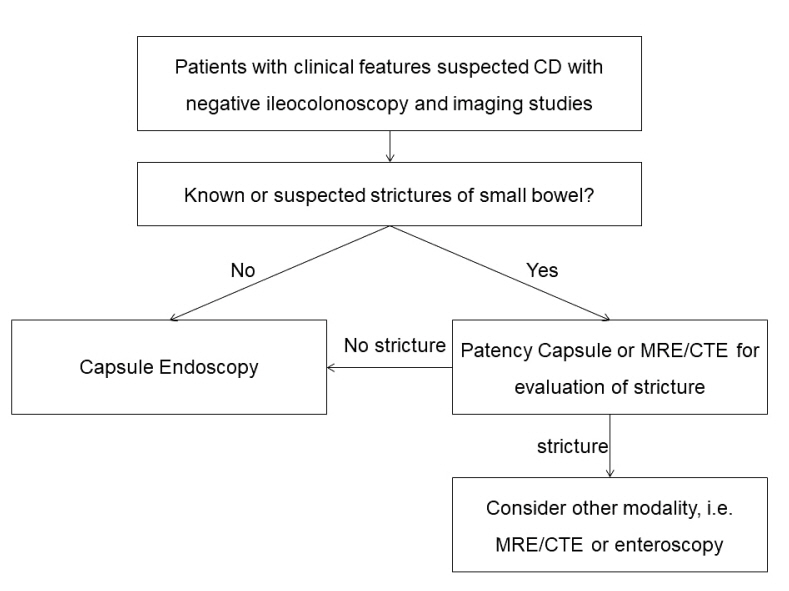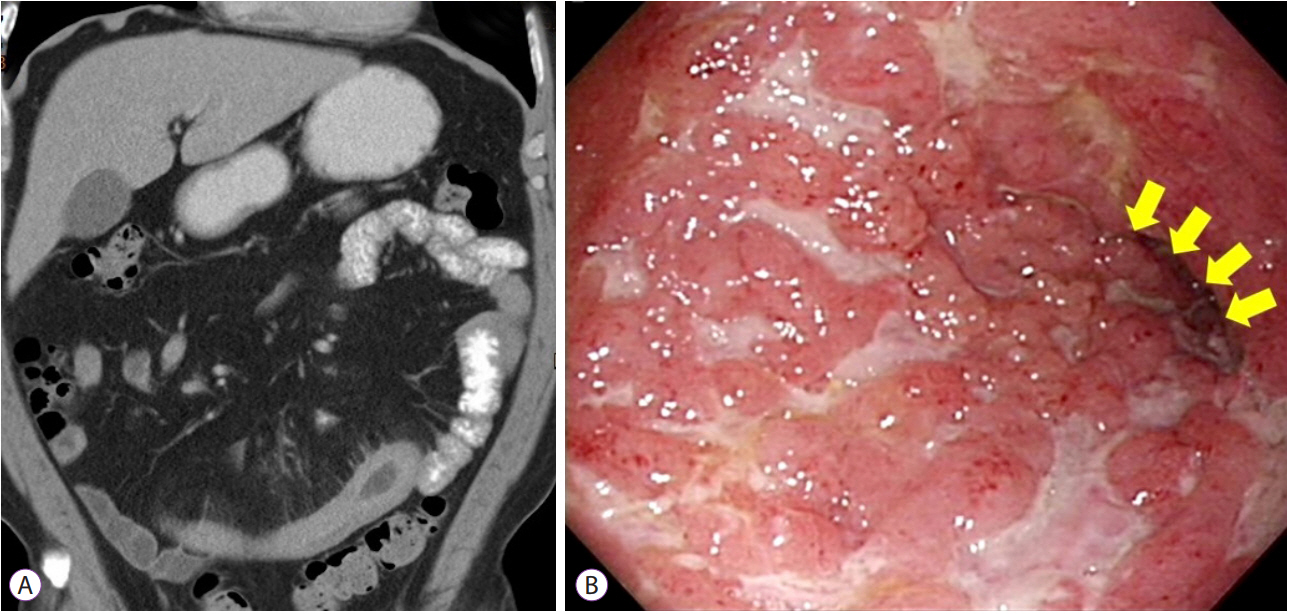Balloon-Assisted Enteroscopy and Capsule Endoscopy in Suspected Small Bowel Crohn's Disease
- Affiliations
-
- 1Department of Gastroenterology, Changhua Christian Hospital, Changhua, Taiwan.
- 2General Education Center, Chienkuo Technology University Changhua, Taiwan.
- 3Division of Gastroenterology, Department of Internal Medicine, MacKay Memorial Hospital, Taipei, Taiwan.
- 4MacKay Junior College of Medicine, Nursing and Management, Taipei, Taiwan.
- 5MacKay Medical College, New Taipei City, Taiwan.
- 6Division of Gastroenterology and Hepatology, Department of Internal Medicine, China Medical University Hospital, Taichung, Taiwan.
- 7Department of Internal Medicine, National Taiwan University Hospital and College of Medicine, Taipei, Taiwan. shuchenwei@ntu.edu.tw
- KMID: 2394740
- DOI: http://doi.org/10.5946/ce.2017.142
Abstract
- Inflammatory bowel diseases are idiopathic inflammatory diseases of two main types, Crohn's disease and ulcerative colitis. Crohn's disease can affect the entire gastrointestinal tract, and the distal ileum is involved in up to 70% of patients. Moreover, Crohn's disease in one-quarter to one-third of patients involves isolation of the small bowel. Due to the nonspecific symptoms and anatomical location of the disease, small bowel Crohn's disease is a phenotype that is particularly difficult to manage. Since the introduction of capsule endoscopy in 2000 and balloon-assisted enteroscopy in the 21st century, it is now possible to directly inspect for small bowel Crohn's disease. However, the new modalities still have limitations, such as capsule retention and invasiveness of balloon-assisted enteroscopy. The diagnostic yields of both capsule endoscopy and balloon-assisted enteroscopy are high for patients with suspected small bowel Crohn's disease. Therefore, earlier use of capsule endoscopy or balloon-assisted enteroscopy can help with the diagnosis and earlier treatment of these patients to avert possible disastrous outcomes.
MeSH Terms
Figure
Cited by 4 articles
-
Meckel's Diverticulum Diagnosed in a Child with Suspected Small Bowel Crohn's Disease
Hyun Sik Kang, Jeong Sub Lee, Chang Rim Hyun, In-Ho Jung, Ki Soo Kang
Pediatr Gastroenterol Hepatol Nutr. 2019;22(1):98-104. doi: 10.5223/pghn.2019.22.1.98.Clinicopathological Features of Small Bowel Tumors Diagnosed by Video Capsule Endoscopy and Balloon-Assisted Enteroscopy: A Single Center Experience
Ah Young Yoo, Beom Jae Lee, Won Shik Kim, Seong Min Kim, Seung Han Kim, Moon Kyung Joo, Hyo Jung Kim, Jong-Jae Park
Clin Endosc. 2021;54(1):85-91. doi: 10.5946/ce.2020.047.Epidemiological trend in inflammatory bowel disease in Taiwan from 2001 to 2015: a nationwide populationbased study
Hsu-Heng Yen, Meng-Tzu Weng, Chien-Chih Tung, Yu-Ting Wang, Yuan Ting Chang, Chin-Hao Chang, Ming-Jium Shieh, Jau-Min Wong, Shu-Chen Wei
Intest Res. 2019;17(1):54-62. doi: 10.5217/ir.2018.00096.Management of Crohn’s disease in Taiwan: consensus guideline of the Taiwan Society of Inflammatory Bowel Disease updated in 2023
Jia-Feng Wu, Hsu-Heng Yen, Horng-Yuan Wang, Ting-An Chang, Chung-Hsin Chang, Chen-Wang Chang, Te-Hsin Chao, Jen-Wei Chou, Yenn-Hwei Chou, Chiao-Hsiung Chuang, Wen-Hung Hsu, Tzu-Chi Hsu, Tien-Yu Huang, Tsung-I Hung, Puo-Hsien Le, Chun-Che Lin, Chun-Chi Lin, Ching-Pin Lin, Jen-Kou Lin, Wei-Chen Lin, Yen-Hsuan Ni, Ming-Jium Shieh, I-Lun Shih, Chia-Tung Shun, Tzung-Jiun Tsai, Cheng-Yi Wang, Meng-Tzu Weng, Jau-Min Wong, Deng-Chyang Wu, Shu-Chen Wei
Intest Res. 2024;22(3):250-285. doi: 10.5217/ir.2024.00060.
Reference
-
1. Hall B, Holleran G, McNamara D. Small bowel Crohn’s disease: an emerging disease phenotype? Dig Dis. 2015; 33:42–51.
Article2. Chang CW, Wei SC, Chou JW, et al. Safety and efficacy of adalimumab for patients with moderate to severe Crohn’s disease: the Taiwan society of inflammatory bowel disease (TSIBD) study. Intest Res. 2014; 12:287–292.
Article3. Wiarda BM, Mensink PB, Heine DG, et al. Small bowel Crohn’s disease: MR enteroclysis and capsule endoscopy compared to balloon-assisted enteroscopy. Abdom Imaging. 2012; 37:397–403.
Article4. Bourreille A, Ignjatovic A, Aabakken L, et al. Role of small-bowel endoscopy in the management of patients with inflammatory bowel disease: an international OMED-ECCO consensus. Endoscopy. 2009; 41:618–637.
Article5. Satsangi J, Silverberg MS, Vermeire S, Colombel JF. The Montreal classification of inflammatory bowel disease: controversies, consensus, and implications. Gut. 2006; 55:749–753.
Article6. Efthymiou A, Viazis N, Mantzaris G, et al. Does clinical response correlate with mucosal healing in patients with Crohn’s disease of the small bowel? A prospective, case-series study using wireless capsule endoscopy. Inflamm Bowel Dis. 2008; 14:1542–1547.
Article7. Iddan G, Meron G, Glukhovsky A, Swain P. Wireless capsule endoscopy. Nature. 2000; 405:417.
Article8. Jensen MD, Brodersen JB, Kjeldsen J. Capsule endoscopy for the diagnosis and follow up of Crohn’s disease: a comprehensive review of current status. Ann Gastroenterol. 2017; 30:168–178.9. Wei SC, Chang TA, Chao TH, et al. Management of Crohn’s disease in Taiwan: consensus guideline of the Taiwan society of inflammatory bowel disease. Intest Res. 2017; 15:285–310.
Article10. Fireman Z, Mahajna E, Broide E, et al. Diagnosing small bowel Crohn’s disease with wireless capsule endoscopy. Gut. 2003; 52:390–392.
Article11. Girelli CM, Porta P, Malacrida V, Barzaghi F, Rocca F. Clinical outcome of patients examined by capsule endoscopy for suspected small bowel Crohn’s disease. Dig Liver Dis. 2007; 39:148–154.
Article12. Enns RA, Hookey L, Armstrong D, et al. Clinical practice guidelines for the use of video capsule endoscopy. Gastroenterology. 2017; 152:497–514.13. American Society for Gastrointestinal Endoscopy Standards of Practice Committee, Shergill AK, Lightdale JR, et al. The role of endoscopy in inflammatory bowel disease. Gastrointest Endosc. 2015; 81:1101–1121. e1-e13.
Article14. Monteiro S, Boal Carvalho P, Dias de Castro F, et al. Capsule endoscopy: diagnostic accuracy of Lewis score in patients with suspected Crohn’s disease. Inflamm Bowel Dis. 2015; 21:2241–2246.15. Gomollón F, Dignass A, Annese V, et al. 3rd European evidence-based consensus on the diagnosis and management of Crohn’s disease 2016: part 1: diagnosis and medical management. J Crohns Colitis. 2017; 11:3–25.
Article16. Bar-Meir S. Review article: capsule endoscopy - are all small intestinal lesions Crohn’s disease? Aliment Pharmacol Ther. 2006; 24 Suppl 3:19–21.
Article17. Annese V, Daperno M, Rutter MD, et al. European evidence based consensus for endoscopy in inflammatory bowel disease. J Crohns Colitis. 2013; 7:982–1018.
Article18. Kopylov U, Yung DE, Engel T, et al. Fecal calprotectin for the prediction of small-bowel Crohn’s disease by capsule endoscopy: a systematic review and meta-analysis. Eur J Gastroenterol Hepatol. 2016; 28:1137–1144.19. Mitselos IV, Christodoulou DK, Katsanos KH, et al. The role of small bowel capsule endoscopy and ileocolonoscopy in patients with nonspecific but suggestive symptoms of Crohn’s disease. Eur J Gastroenterol Hepatol. 2016; 28:882–889.
Article20. Choi M, Lim S, Choi MG, Shim KN, Lee SH. Effectiveness of capsule endoscopy compared with other diagnostic modalities in patients with small bowel Crohn’s disease: a meta-analysis. Gut Liver. 2017; 11:62–72.
Article21. Dionisio PM, Gurudu SR, Leighton JA, et al. Capsule endoscopy has a significantly higher diagnostic yield in patients with suspected and established small-bowel Crohn’s disease: a meta-analysis. Am J Gastroenterol. 2010; 105:1240–1248. quiz 1249.
Article22. Tukey M, Pleskow D, Legnani P, Cheifetz AS, Moss AC. The utility of capsule endoscopy in patients with suspected Crohn’s disease. Am J Gastroenterol. 2009; 104:2734–2739.
Article23. Hall B, Holleran G, Costigan D, McNamara D. Capsule endoscopy: high negative predictive value in the long term despite a low diagnostic yield in patients with suspected Crohn’s disease. United European Gastroenterol J. 2013; 1:461–466.
Article24. Monteiro S, Dias de Castro F, Boal Carvalho P, et al. Essential role of small bowel capsule endoscopy in reclassification of colonic inflammatory bowel disease type unclassified. World J Gastrointest Endosc. 2017; 9:34–40.
Article25. Jensen MD, Nathan T, Rafaelsen SR, Kjeldsen J. Diagnostic accuracy of capsule endoscopy for small bowel Crohn’s disease is superior to that of MR enterography or CT enterography. Clin Gastroenterol Hepatol. 2011; 9:124–129.
Article26. Harrington C, Rodgers C. The longest duration of retention of a video capsule. BMJ Case Rep. 2014; 2014.
Article27. Cave D, Legnani P, de Franchis R, Lewis BS; ICCE. ICCE consensus for capsule retention. Endoscopy. 2005; 37:1065–1067.
Article28. Eliakim R. Video capsule endoscopy of the small bowel. Curr Opin Gastroenterol. 2013; 29:133–139.
Article29. Rezapour M, Amadi C, Gerson LB. Retention associated with video capsule endoscopy: systematic review and meta-analysis. Gastrointest Endosc. 2017; 85:1157–1168.e2.
Article30. Park SK, Ye BD, Kim KO, et al. Guidelines for video capsule endoscopy: emphasis on Crohn’s disease. Clin Endosc. 2015; 48:128–135.
Article31. Van de Bruaene C, De Looze D, Hindryckx P. Small bowel capsule endoscopy: where are we after almost 15 years of use? World J Gastrointest Endosc. 2015; 7:13–36.32. Cooley DM, Walker AJ, Gopal DV. From capsule endoscopy to balloon-assisted deep enteroscopy: exploring small-bowel endoscopic imaging. Gastroenterol Hepatol (N Y). 2015; 11:143–154.33. Tharian B, Caddy G, Tham TC. Enteroscopy in small bowel Crohn’s disease: a review. World J Gastrointest Endosc. 2013; 5:476–486.
Article34. Yamamoto H, Sekine Y, Sato Y, et al. Total enteroscopy with a nonsurgical steerable double-balloon method. Gastrointest Endosc. 2001; 53:216–220.
Article35. Rahman A, Ross A, Leighton JA, et al. Double-balloon enteroscopy in Crohn’s disease: findings and impact on management in a multicenter retrospective study. Gastrointest Endosc. 2015; 82:102–107.
Article36. Jang HJ, Choi MH, Eun CS, et al. Clinical usefulness of double balloon enteroscopy in suspected Crohn’s disease: the KASID multi-center trial. Hepatogastroenterology. 2014; 61:1292–1296.37. Tun GS, Rattehalli D, Sanders DS, McAlindon ME, Drew K, Sidhu R. Clinical utility of double-balloon enteroscopy in suspected Crohn’s disease: a single-centre experience. Eur J Gastroenterol Hepatol. 2016; 28:820–825.38. Moschler O, May A, Müller MK, Ell C; German DBE Study Group. Complications in and performance of double-balloon enteroscopy (DBE): results from a large prospective DBE database in Germany. Endoscopy. 2011; 43:484–489.
Article39. Manno M, Barbera C, Bertani H, et al. Single balloon enteroscopy: technical aspects and clinical applications. World J Gastrointest Endosc. 2012; 4:28–32.
Article40. Kim J. Training in endoscopy: enteroscopy. Clin Endosc. 2017; 50:328–333.
Article41. Riccioni ME, Urgesi R, Cianci R, Spada C, Nista EC, Costamagna G. Single-balloon push-and-pull enteroscopy system: does it work? A single-center, 3-year experience. Surg Endosc. 2011; 25:3050–3056.
Article42. Di Nardo G, Oliva S, Aloi M, et al. Usefulness of single-balloon enteroscopy in pediatric Crohn’s disease. Gastrointest Endosc. 2012; 75:80–86.
Article43. de Ridder L, Mensink PB, Lequin MH, et al. Single-balloon enteroscopy, magnetic resonance enterography, and abdominal US useful for evaluation of small-bowel disease in children with (suspected) Crohn’s disease. Gastrointest Endosc. 2012; 75:87–94.
Article44. Takenaka K, Ohtsuka K, Kitazume Y, et al. Comparison of magnetic resonance and balloon enteroscopic examination of the small intestine in patients with Crohn’s disease. Gastroenterology. 2014; 147:334–342.e3.
Article45. Seiderer J, Herrmann K, Diepolder H, et al. Double-balloon enteroscopy versus magnetic resonance enteroclysis in diagnosing suspected small-bowel Crohn’s disease: results of a pilot study. Scand J Gastroenterol. 2007; 42:1376–1385.
Article46. Wei SC. Differences in the public medical insurance systems for inflammatory bowel disease treatment in Asian countries. Intest Res. 2016; 14:218–223.
Article47. Arulanandan A, Dulai PS, Singh S, Sandborn WJ, Kalmaz D. Systematic review: safety of balloon assisted enteroscopy in Crohn’s disease. World J Gastroenterol. 2016; 22:8999–9011.
Article
- Full Text Links
- Actions
-
Cited
- CITED
-
- Close
- Share
- Similar articles
-
- Recent developments in small bowel endoscopy: the “black box” is now open!
- Capsule Endoscopy in Children
- Diagnostic and Therapeutic Capability of Double-Balloon Enteroscopy in Clinical Practice
- The role of small bowel endoscopy in small bowel Crohn's disease: when and how?
- Indications for Enteroscopy: Which Patients Should Be Recommended for Enteroscopy?





